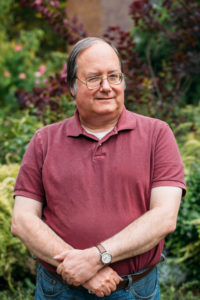Steve Harrison
Blue Collar to White Collar
By Linda Norlen

Steve Harrison is a lead Contract Administrator who develops and oversees Lighthouse contracts. His duties also include pricing, orders, and customer service.
Born in Wisconsin, Steve came to Seattle at age six. Near-sighted and color blind, he was “mainstreamed” in public school. Academically school was fine, he says, but socially it was often difficult. “Children can be cruel to people who are different from them.” Even in high school, it was still a problem. Most of Steve’s friends in school were kids with similar disabilities, but because they were all transported to school from afar, he didn’t have childhood friends readily near his home and had few sighted friends as a child. Only as an adult did he make friends with people who were sighted.
Like many Lighthouse workers, Steve can name the precise date he started working here, June 24, 1974. That’s when he began as a summer worker, his first full-time job. He also remembers the day because there was a strike at a Pepsi plant down the street and one of its striking workers tried to stop Steve from going to work that day.
His first Lighthouse job was in mops and housewares, which the company no longer produces. Steve continued as a summer and part-time worker in manufacturing until after he graduated from the University of Washington with a B.A. in Accounting.
While in college, Steve says the state Department of Services for the Blind (DSB) helped make his education accessible. Steve mainly faced difficulty getting tests and other learning materials from instructors. Sometimes DSB would be able to help with this, but Steve often had to find other ways to work around what he lacked.
Originally, Steve had planned to get an accounting job after graduation, but never got one and joined the Lighthouse full time instead. After spending about 20 years in manufacturing, Steve was pleased when he transferred to “the white collar side” of the Lighthouse in 1997. That year, the accounting department hired him and a couple of years later he was promoted to contract administration. One of the positive changes Steve has seen at the Lighthouse is the hiring of more people who are blind to office positions, not only to manufacturing jobs.
Former Vice President, Emil Dupuy is one of the people who pushed for more such hires, and he supported Steve in getting his first office position. Renee Obrycki also believed in Steve.
Another person he credits as being helpful is his current boss Janet Lenhardt, who he says is very supportive of the mission of the Lighthouse and encouraging to him in his career. “She’s a good boss to work for.”
When he started working here in the 1970s, he could not have believed he would be here for more than 40 years. He is pleased that he achieved more in the last half of his career than he did in the first half.
When not at work, Steve likes to read, study chess, and enjoy music.
Steve is impressed by the way the Lighthouse has implemented computers into both white-collar and blue-collar jobs and has moved into advanced, up-to-date manufacturing for both the aerospace industry and the government. Looking into the future, as advancements in technology could make the workforce here smaller (as is happening widely in manufacturing elsewhere), he wonders whether the Lighthouse can continue to meet its double bottom line of being profitable and also responsive to the human needs of its employees. He hopes the Lighthouse can continue to meet this challenge for the next 100 years.